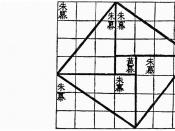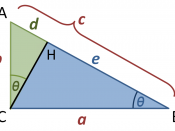Trigonometry uses the fact that ratios of pairs of sides of triangles are functions of the angles. The basis for mensuration of triangles is the right-angled triangle. The term trigonometry means literally the measurement of triangles. Trigonometry is a branch of mathematics that developed from simple measurements.
A theorem is the most important result in all of elementary mathematics. It was the motivation for a wealth of advanced mathematics, such as Fermat's Last Theorem and the theory of Hilbert space. The Pythagorean Theorem asserts that for a right triangle, the square of the hypotenuse is equal to the sum of the squares of the other two sides. There are many ways to prove the Pythagorean Theorem. A particularly simple one is the scaling relationship for areas of similar figures.
Did Pythagoras derive the Pythagorean Theorem or did he piece it together by studying ancient cultures; Egypt, Mesopotamia, India and China? What did these ancient cultures know about the theorem? Where was the theorem used in their societies? In 'Geometry and Algebra in Ancient Civilizations', the author discusses who originally derived the Pythagorean Theorem.
He quotes Proclos, a commentator of Euclid's elements, 'if we listen to those who wish to recount the ancient history we may find some who refer this theorem to Pythagoras, and say that he sacrificed an ox in honor of his discovery'. If this statement is considered as a statement of fact, it is extremely improbable, for Pythagoras was opposed to the sacrifice of animals, especially cattle. If the saying is considered as just a legend, it is easy to explain how such a legend might have come into existence. Perhaps the original form of the legend said something like he who discovered the famous figure sacrificed a bull in honor of his discovery.
Van der...


